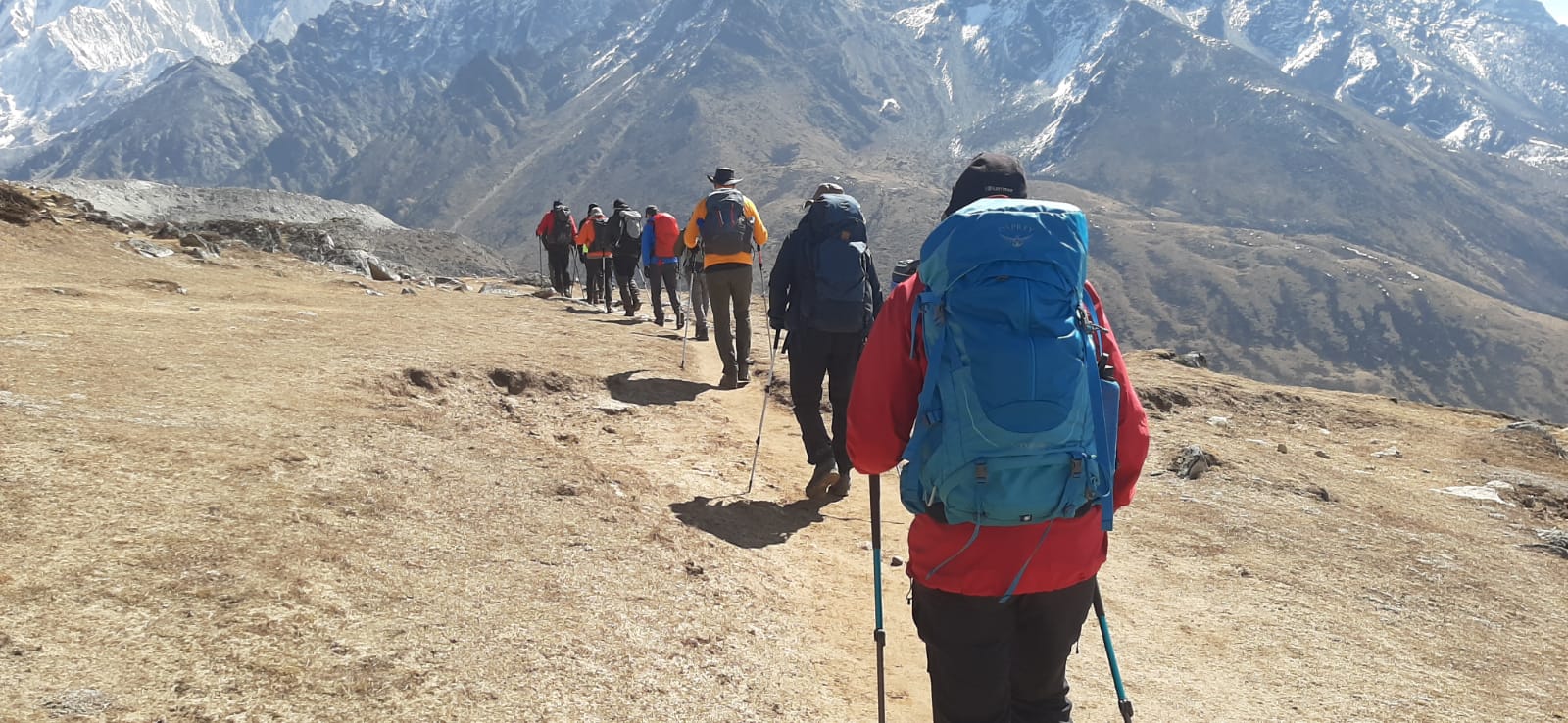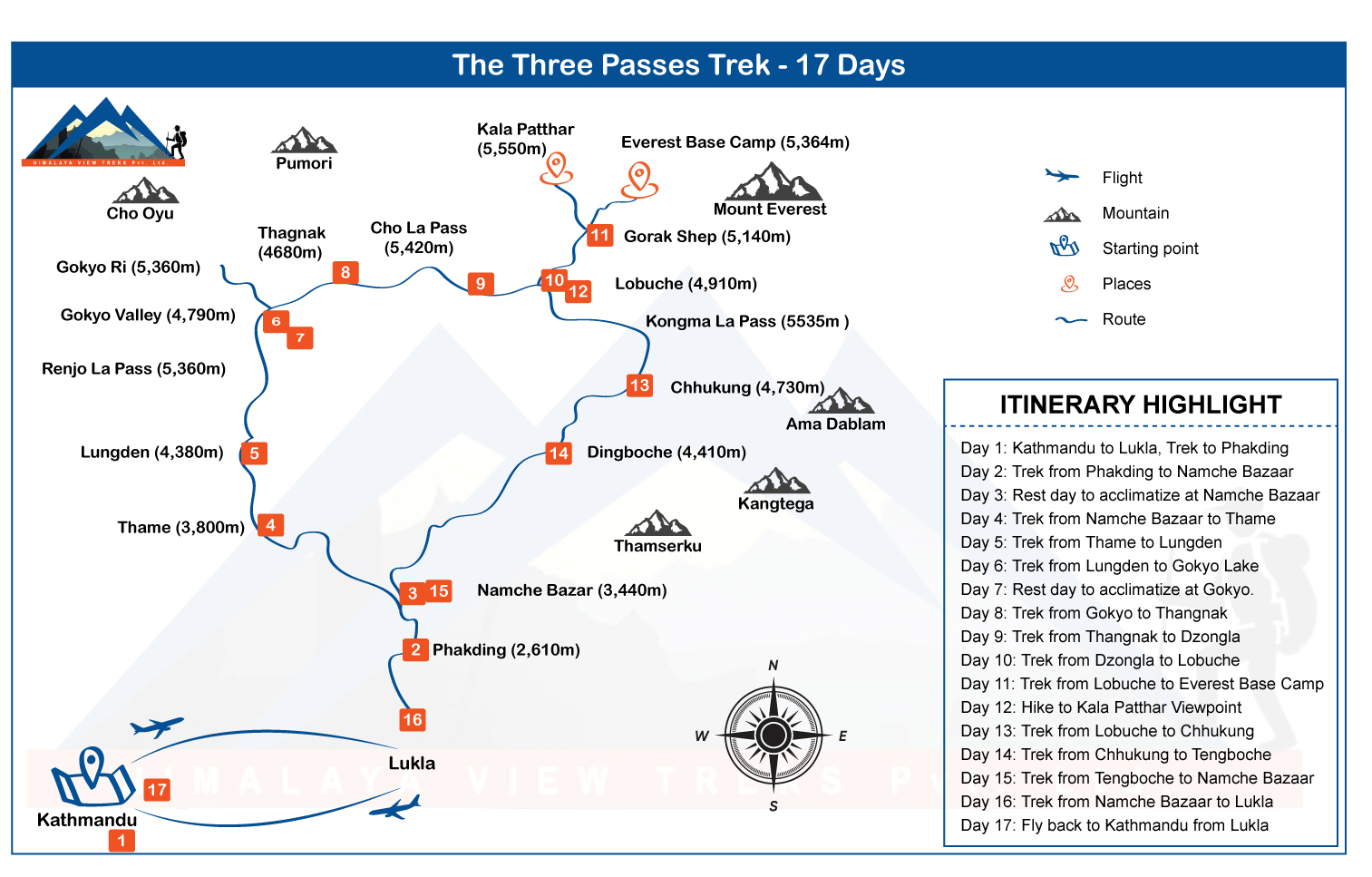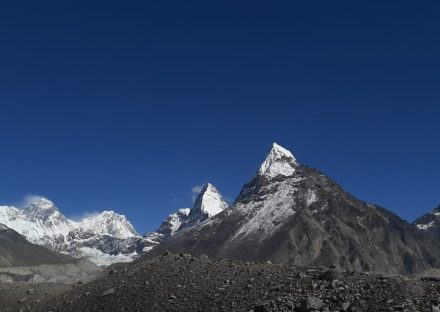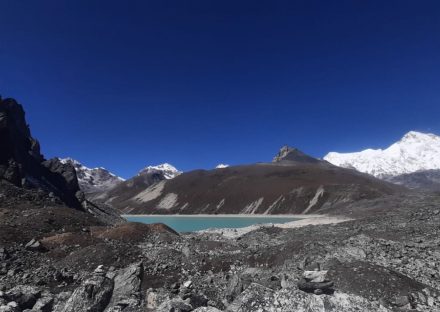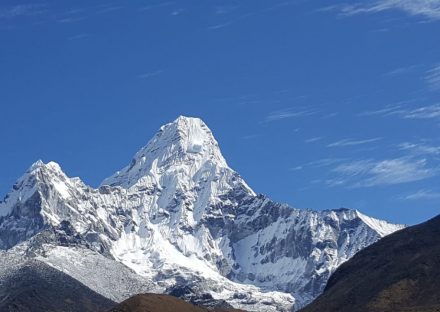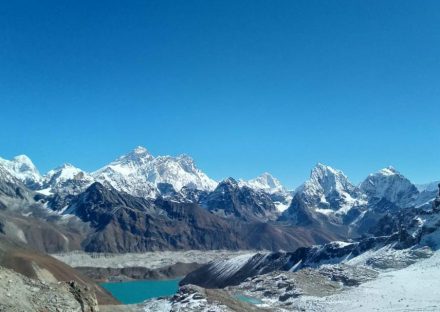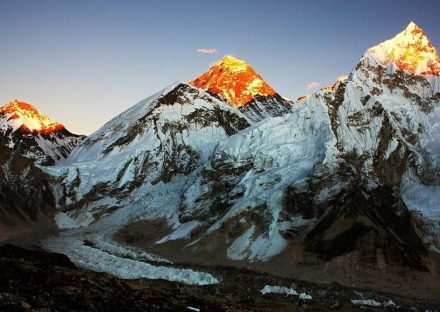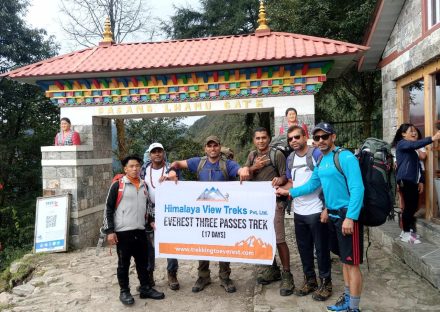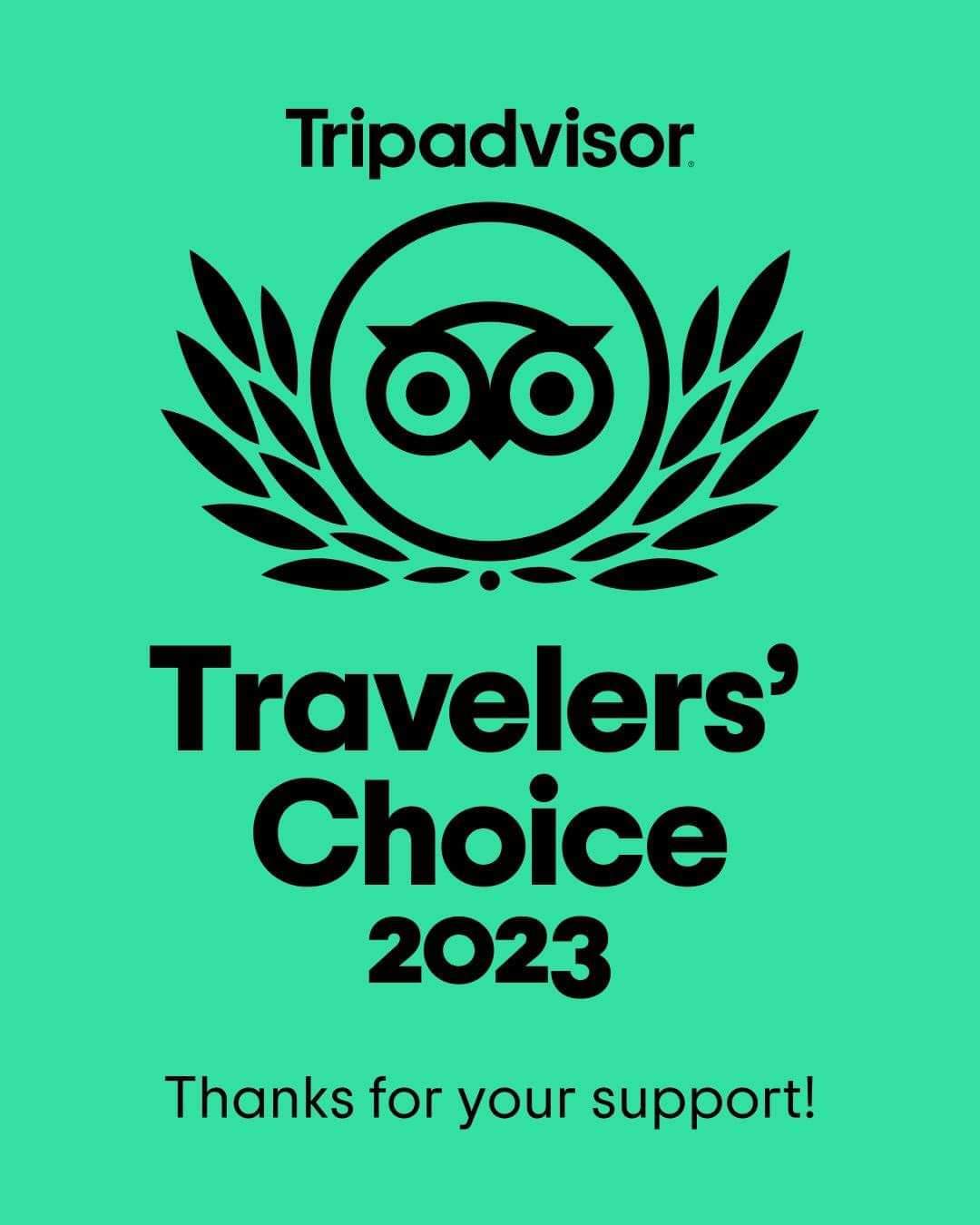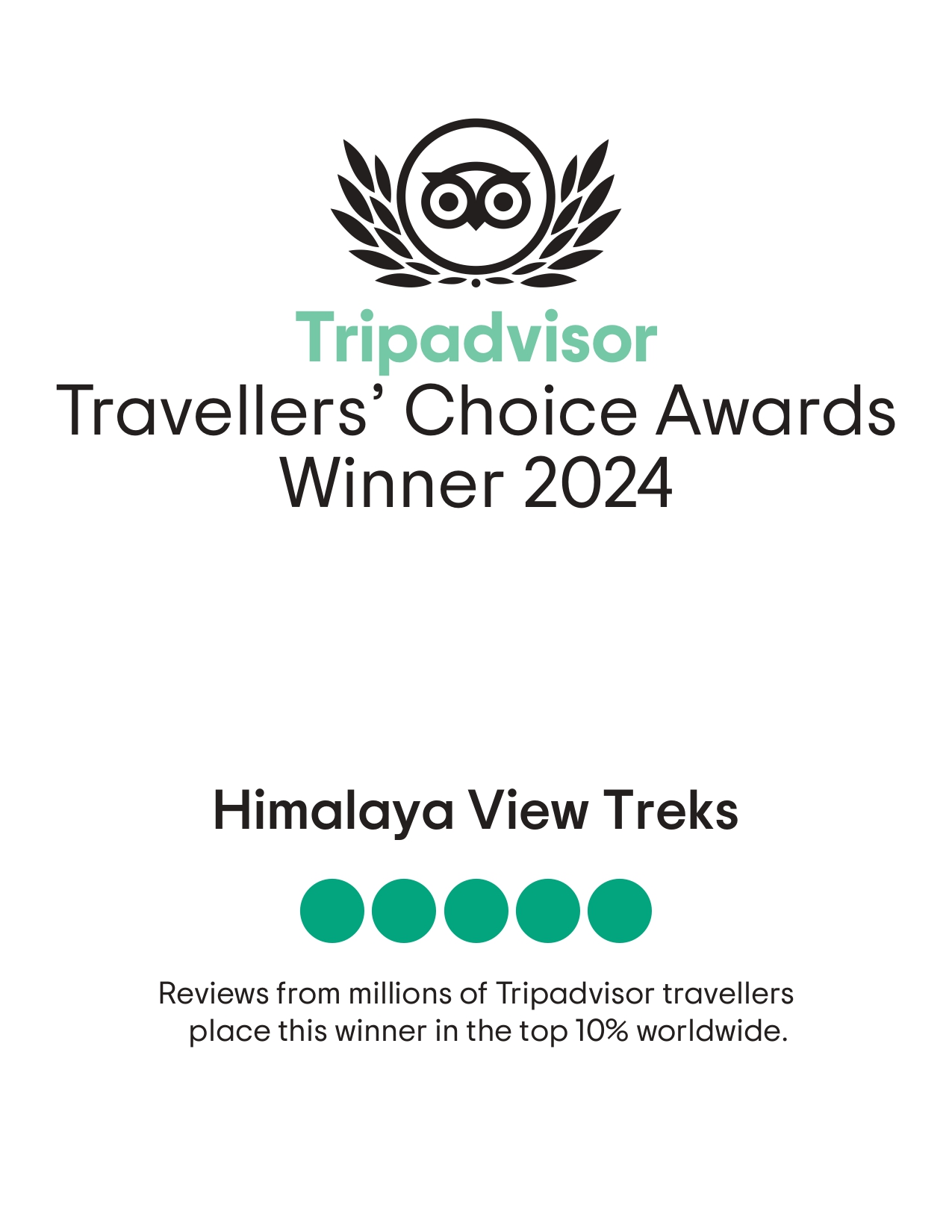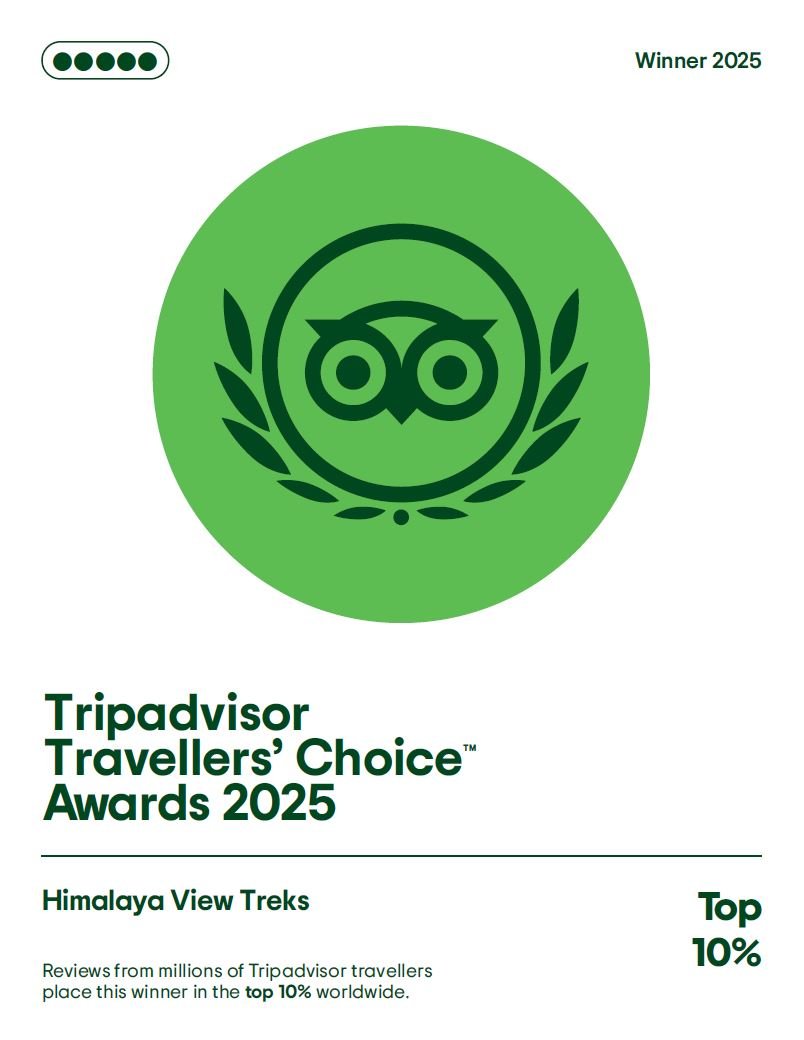- Details
- Short Itinerary
Detailed itinerary
Itinerary- Tour Includes/Excludes
- Useful Info
- Map
- Photos
- FAQ
Trip overview
Everest Three Passes Trek – 17 Days
The Everest Three Passes Trek (17 Days) is a classic adventure into the wild and high alpine country of the Khumbu region in Nepal. On a journey like this, it’s not the mountains we conquer, but ourselves. Nature will test your mental and physical endurance on this epic trek filled with natural wonders and unmatched beauty.
Everest Three Passes Trek is a one-stop adventure through some of the most rugged and remote trails on Earth. Every step rewards you with breathtaking Himalayan panoramas and unforgettable moments. Designed for true adventure lovers, this trek challenges you to cross three of the highest mountain passes in the Everest region — Renjo La (5,340m), Cho La (5,420m), and Kongma La (5,535m) — each offering lifetime experiences and awe-inspiring views.
Along the route, we also hike to Everest Base Camp (5,364m) and the turquoise Gokyo Lakes, making this journey one of the most complete and rewarding trekking adventures in Nepal. The Everest Three Passes Trek connects the main highlights of the Khumbu Pasang Lhamu rural municipality while taking you through less-visited trails and authentic Sherpa villages.
Best Time to Trek Everest Three Passes
The ideal seasons for the Everest Three Passes Trek are March to May (spring) and September to November (autumn) — when the weather is clear, and the mountain views are spectacular.
Anti-clockwise route or clockwise route?
The trek usually follows either a clockwise or anti-clockwise route. While the anti-clockwise route is more challenging, the clockwise direction (starting with Renjo La Pass) is considered slightly easier and offers better acclimatization.
Moreover, Your adventure begins with a scenic flight to Lukla, followed by a hike to Namche Bazaar, the bustling capital of the Khumbu region. From there, the trail leads to the charming village of Thame, known for producing famous high-altitude climbers. Continuing onwards, you’ll reach the pristine Gokyo Lakes before crossing Renjo La Pass. The journey continues across Cho La and Kongma La, with side hikes to Gokyo Ri (5,357m) and Kala Patthar (5,545m). Both View point offering magnificent close-up views of Mt. Everest.
Everest Three Passes Trip Highlights
- Cross three major high passes — Renjo La, Cho La, and Kongma La — all over 5,000 meters.
- Climb Gokyo Ri (5,357m) and Kala Patthar (5,545m) for the best panoramic views of Mt. Everest.
- Visit Everest Base Camp (5,364m) and admire the legendary Khumbu Icefall.
- Explore the famous Gokyo Lakes and Ngozumpa Glacier — the largest glacier in Nepal.
- Walk through traditional Sherpa villages like Khumjung, home to the Hillary School, Hillary Hospital, and the Yeti Skull Monastery.
- Cross the iconic Hillary Bridge and explore Namche Bazaar.
- Witness wildlife such as wild yaks and reach close to the Tibet border.
- Stay overnight at Gorakshep (5,140m) — the highest teahouse stop in the world.
- Enjoy grand views of Everest, Lhotse, Makalu, Cho Oyu, and Cholatse, among many other Himalayan giants.
Experience of a Lifetime
Furthermore, The Everest Three Passes Trek is not just a trek — it’s a test of endurance, spirit, and courage. With each high pass, you’ll earn unparalleled mountain views and unforgettable moments. From turquoise lakes to glacial crossings and legendary Sherpa culture, this journey offers it all. October is one of the best months to undertake this adventure, with crisp air, crystal-clear skies, and incredible visibility. Hiking up Kala Patthar during this time will leave you mesmerized by the closest and most spectacular view of Mt. Everest — so close, it feels almost within reach.
However, With Himalaya View Treks, you’ll be guided by experienced local Sherpa guides and supported by strong, reliable porters who know every corner of Everest region. The 17-day itinerary is carefully designed for safe acclimatization and a truly fulfilling Himalayan experience. Challenge yourself on the Everest Three High Passes Trek — an unforgettable journey of guts, glory, and grandeur.
Short Itinerary
Everest Three Passes Trek - 17 Days Itinerary
Day 01: Fly to Lukla 30 Minutes (2800m/9156ft and trek to Phakding (walking distance 6 km (2/3 hours) 2640m/8659ft
Day 02: Trek to Namche Bazaar walking distance 7.4 km (6/7 hours) 3440m/11283ft)
Day 03: Rest day in the same place for acclimatization ( Hike to Everest View Hotel )
Day 04: Trek From Namche to Thame walking distance 6.8 km (4 hours) 3800m/12464ft
Day 05: Thame to Lungdeng walking distance 8.6 km (5/6 hours) 4600m/15088ft
Day 06: Lungdeng to Gokyo (4760m.15612ft) via Renjo pass walking distance 6/7 hours (5360m/17580ft)
Day 07: Acclimatization day, Hike to Gokyo Peak walking distance 1.3km (4/5 hours) 5560m/18236ft)
Day 08: Gokyo to Tangnak walking distance 3.7 km ( 4 hours) 4700m/15416ft
Day 09: Thannak to Zhong la via Cho La Pass walking distance 9.4km (6/7 hours) 5417m/17767ft
Day 10: Zhong La to Lobuche walking distance 6.6km (4 hours) 4930m/16170ft
Day 11: Lobuche to Gorakshep walking distance of 4.5km. (3 hours) 5140m/16859ft) Everest base camp 5346m/17593ft
Day 12: Hike to Kalapattar (5545m/18187ft) and trek back to Lobuche walking distance of 3.9 km (2/3 hours)
Day 13: Lobuche to Dingboche via Kongma-La (5535m/18154ft) 7 hours walking)
Day 14: Dingbiche to Tengboche walking distance of 9.1 km (5/6) hours. (3860m/12660ft)
Day 15: Tengboche to Namche Bazaar walking distance (5/7 hours) 5.9km. (3440m/11283ft) 6/7
Day 16: Namche to Lukla walking distance of 13.5 km (6/7 hours) (2800m/9184ft)
Day 17: Fly back to Kathmandu early in the morning around 07:00 AM (35 minutes)
Detailed Itinerary
1. Fly to Lukla and trek to Phagding
Early in the morning the guide will pick you at the hotel and head to domestic terminal for the flight to Lukla. The 35 minutes flight from Kathmandu to Lukla is amazing. It can be termed as the mountain flight as well. You get to see plethora of mountains. The landing at the Tenzing Hillary airport is also the experience to gather. As the airstrip is the world's most extreme airport. We will meet the rest of the crew members in Lukla. After short coffee break, we will start to walk to Phakding. The trail is easy as it traverse through small hamlets, streams, Mani walls and suspension bridges.
2. Trek to Namche Bazar
Trek to Namche Bazaar (3440m.) via Jorsalle, Hillary Bridge adn Top danda to Namche ( 6/7 hours walking) stay overnight at Lodge.
We will start our trek after breakfast. Today's trail is marvelous. We will enter the Sagarmatha National Park in Manjo. There are more than 5 suspension bridges in the trail. The trail is easy to walk on and you will have to cross many suspension bridges. The most interesting suspension bridge to cross is the Twin Hillary bridge at the foothill of Namche Bazaar. We will also get the first glimpse of Mt. Everest today. Just before reaching Namche, you can get an amazing view of Mt. Everest for the first time if weather permits. In the evening you can stroll around the marketplace. Namche Bazaar is the biggest Sherpa town on the Everest Base Camp Trek.
3. Acclimatization day
Acclimatization day, Hike to Everest view hotel (3,880m) and Khumjung village, including Hillary school and hospital
On this day we will do our first acclimatization exercises. Today's main purpose is to reach high altitude and rest in low altitude. You can get the splendid scenery of mountains like Tabuche, Lhotse, Nuptse etc.
After visiting the Sherpa Mountain Museum, we will return back to our teahouse/lodge.
4. Trek to Thame
Trek to Thame (3800m) 4 hours walking, overnight at a lodge, this village is well known by all Everest climbers and the starting point of the three passes trek.
We will leave the main trekking trail of Everest Base Camp and head to Thame. If we trek following the left trail, we will reach to Everest Base Camp but right trekking trail takes us to Thame. For about 4 hours we trek on the trail starting from the right side of Namche Bazaar.
Thame village is the best village of Sherpa people. The village is known as the society of Everest Summitteers. Therefore, you can get to hear lots of mountaineering stories during stay in Thame village.
5. Trek to Lumde
Trek to Lumde (Lungdeng) (4600m) 5/6 hours walking) stay overnight at Lodge.
We will continue our trekking after breakfast. On this day we will trek to Lumde. It is the best day to observe surrounding Khumbu landscape as well as Sherpa culture & rituals.
6. Cross Renjo la pass to Gokyo
Finally, today is the day to cross the first high pass in our three high passes trek journey. It takes about 6-7 hours to cross the pass. From the top of the pass, we can see mountains like Everest, Choyou, Lhotse and Makalu. These mountains are within the top ten mountainsof the world. The final destination on this day is Gokyo Lake area. Enjoy your strolling on the shores of the lake and get the picturesque vibes today. Relish the chance to experience the blue turquoise lake and peaceful Sherpa hamlets.
Trek to Gokyo (4760m.) via Renjo pass (5435) 6 hours walking) stay overnight at Gokyo.
7. Hike to Gokyo Ri
It is a spare rest day. However you can hike to Gokyo Ri and get the outstanding 360 degree view of mountains. Visit Gokyo Ri (Gokyo Peak 5560m.) in the morning (4 ½ hours walking) for sunrise view and all-mountain views, from here we able to see 4 mountains more than eight thousand meters high. Mt. Everest, Mt. Makalu, Mt, Lhotse and Mt Cho yo. Hike back to Gokyo and stay overnight at same Lodge.
8. Trek to Thagnak
Trek to Tangnak ( 4700m. via Gokyo Ngozumpa glacier, 5 hours walk, overnight at the lodge in Thagnak
After breakfast, we will continue our trekking to Thagnak. The trail is over the rugged rocky terrain in the Ngozumba glacier. We will rest and relax as tomorrow early in the morning we will have to cross the Chola Pass.
9. Chola Pass to Zhong La
Trek to Zhong la via Chola Pass (5320m. 6/7 hours walking) stay overnight at lodge
In the wee hours, we will start the trekking. We will take the packed breakfast. It is necessary to walk the trail as early as possible. From the top of Chola Pass, we will be able to see panoramic view of mountains. The landscape is amazing. You can get the best pictures from the top. Heed the instructions of the guide while descending to Zhong La. Rest and relax in the evening.
10. Trek to Lobuche
Easy day, Trek to Lobuche (4930m. 4 hours walking) stay overnight at Lodge.
Today is an easy day to walk. We will casually walk on the trail enjoying the view of mountains to Lobuche. Evening in Lobuche is peaceful and you can get the best view of Mt. Pumori and Lobuche.
11. Trek to Gorakshep
Trek to Gorakshep ( 5140m. 3-hour walking, same day visit to Everest base camp and back to Gorakshep, overnight at Lodge,
Today, we will reach the Everest Base Camp. Early in the morning, we will walk on the moraine and glacier to Gorakshep. After checking in at the lodge, we will hike to Everest Base Camp. Enjoy your time being at the base camp of the world's tallest mountain Mt. Everest. After exploring the base camp area, we will return back to Gorakshep for overnight stay.
12. Hike to Kalapathar and trek back to Labuche
Visit Kalapattar (5545m.) Early in the morning for the best Everest view and then trek back to Lobuche (5 hours walking stay Overnight at lodge.
In the wee hours, we will hike to the top of Kalapathar. You will have to follow the instructions of the guide. It is still dark as we are hiking to the top of the hill for sunrise. The sunrise from the top is splendid. You can get the best view of Mt. Pumori and Mt. Everest. After returning back from the top, we will have breakfast and retrace back to Lobuche.
13. Cross to Kongma-La (5535m)
Cross to Kongma-La (5535m) 7 hours walking) stay overnight at Lodge in Dingboche.
Early in the morning, we will start to trek towards the top of the Kong Ma La Pass. At first we will trek on the glacier and trek uphill to the top. The trail is narrow and rugged. Always heed the instructions of the trekking guide. Don't wander on your own. There are many crevasses and vertical trails. Don't trek on your own. Upon crossing the pass we will reach Chhukung. If time permits, we will trek further to Dingboche for the overnight sleep.
14. Trek back to Tengboche
Trek back to Tyangboche (3860m) 5 hours walking) and stay overnight at Lodge.
The return trek in any trekking trails is amazing as the altitude decreases, air density to increases. It makes easier to breathe and enjoy the surrounding scenery. We will explore the monastery in the evening. Enjoy the view of Mt. Amadablam, Pangboche Valley and Namche Valley from the top of the Tengboche.
15. Trek back to Namche
Trek back to Namche Bazaar (3440m. 6/7 hours walking) and stay overnight at Lodge.
We will have to trek downhill to Phungi Thanga and again climb uphill to Kyangjuma. The trail traverses through green lush forests. Upon reaching the Namche Bazaar we will complete the circumambulation of the Khumbu circuit.
16. Trek Back to Lukla
Trek back to Lukla ( 2800m. 7/8 hours walking) and overnight at Lodge.
We will trek through Manjo and Phakding to Lukla. In the evening we will bid farewell to our crew members. We will also celebrate our trek success.
17. Fly back to Kathmandu
Fly back to Kathmandu early in the morning around 07:00 AM (35 minutes) overnight at your own hotel.
We will fly back to Kathmandu. The guide will take you back to your own hotel. In the evening the agency will host the farewell dinner at the Nepalese style cultural restaurant. We will discuss the trip feedback as well.
Included
- Airport pickup and drop as per client’s arrival and departure date
- Hotel- domestic airport- hotel by car/ van, depend on group sizes
- Domestic flights (Kathmandu - Lukla - Kathmandu) tickets including airport taxes
- All meals (Breakfast, lunch, and dinner) during your Everest Three passes Trek
- 16 nights Hotel Accommodation during Everest Three passes Trek
- Government licensed holder, fluent English Speaking, Familiar HVT guide
- Assistant guide if Group sizes is more than 10 trekkers)
- Guide and Porter wages including their meals, accommodation, and Salary
- Staff insurance including medication coverage
- Guide and Assistance both ways Lukla flight Ticket
- Strong local Porters for Carry trekker’s luggage One porter every 2 trekkers
- Water purification drop or tablets for safe drinking water
- Sagarmatha National Park entry permit fee
- Khumbu Pashang Lhamu Rural Municipality permits fees
- Seasonal fresh fruits every day during Everest Three passes trek
- Oximeter to measure Pulse and oxygen level
- Himalaya View Treks Company T-shirt as a Souvenirs and duffel bag if you needed
- Safe storing at company store during the trek
- Local government, taxes, including official Service Charge
- Trip completion Certificate
Not Included
- Hotel accommodation and meals In Kathmandu
- Personal expense (shopping, snacks, boil bottle water, hot (tea, coffee) and cold drinks, hot shower, alcohol, Wi-Fi, telephone call, battery charge fee during the Everest three passes Trek)
- Personal clothing and trekking gear
- Sleeping bag and down jacket available for rent in our store
- Personal travel insurance including evacuation coverage (compulsory) up to 6000m)
- Additional costs if delays flights and outside the itinerary
- All the costs and expenses which are not mentioned in includes list
- Tips for Guide and Porters at the end of the treks
Useful Info
Useful Information for Everest Three Passes Trek – 17 Days
Difficulty Level
Accommodation & Meals
Trek Route Variations
Travel Insurance
Equipment List for the Everest High Passes Trek
FAQs
-
How difficult is the 3 high passes trek?
The Everest High Passes Trek is also known as the Three Passes Trek or Everest Base Camp via Three Passes Trek or High Land of Everest Valley Trek. It is one of the hardest trips that Himalaya View Treks provides to its bold & brave trekkers and adventure-seekers. The journey is known to be a complete circle of high alpine country within the Everest Valley following the treacherous three passes of Renjo La, Cho La and Kongma La before Everest Base Camp visit. The taxing trip is indeed a long walk in remote land, high up in the mountains in the middle of nowhere. For this adventurous trek, you must be very fit and highly experienced in the Himalayas. We highly recommend trekkers and keen hikers to first do the Everest Base Camp Trek or Gokyo Lakes Trek before making a go for this one. Following this adventure pattern could make your issues a lot more comfortable for the 3 high passes. Once you’re done with the high passes, you can graduate for the big time peaks like ‘Island peak or Mera peak’’ & then target the 7 thousanders from there on, if you’re an ardent mountaineer. However, if you are a tested trekker or have already experienced the Kilimanjaro Climb or trekked in the Andes or on the Alps, then you are unquestionably eligible for this one.
-
When is the best time to do the 3 high passes trek?
Everest High Passes Trek is best done in pre-monsoon season i.e. from March to May and post-monsoon season i.e. from late September to December. It is also possible to do this trek in February and early September but the trek is best preferred in early autumn. September/October would be ideal & wonderful.
-
Is my trip departure guaranteed?
Absolutely yes! Under normal circumstances, our booked trips are guaranteed to run. You will still be doing your trek even if other trekkers cancel their trip. This is the reason why Himalaya View Treks is small but highly dependable; we’re somewhat different from other agencies, who usually cancel their whole trip a month or even a week before the trip date. We are a tailor-made outfit and the number of participants does not stop our operation. If your trip has been canceled by your operator and you are on a last-minute stress mode, remember to find us to sort out your trip decisions. Please feel free to book your stress-free holidays with us. Unless there is a situation which is beyond our control i.e. a political riot, natural disasters, pandemics, epidemics or weather catastrophes affecting one & all, our trips are 100% guaranteed to run.
-
If I cancel my trip, will I get a refund?
Himalaya View Treks offers a lifetime deposit policy which allows you the flexibility to transfer your deposit to anyone or any other trip. If you wish to cancel your booked trips, certain cancelation charges apply. Please visit our booking terms and conditions for detailed information.
-
Who are my guides, are they experienced enough for such a trip?
You will be guided by our experienced trek leaders who have been to the Three Passes and back multiple times for years. All our guides are locals who communicate very well in English and possess deep knowledge of the mountains, people, culture, health, hygiene, and most importantly, your safety. They give more priority to your life than their own. Our guides simply enjoy what they do; it’s their only means of survival.
-
Where will I sleep at nights for a high altitude trek like this?
After a long day’s hike, a relaxing night of comfortable sleep is very much vital for the next day’s walk. Taking your comfort into account, we make sure to book the best lodge with two beds in each room and western toilet facilities wherever available. Normally, the beds are clean and comfortable with an electric blanket (upon availability) and attached bathrooms for most nights. The room’s temperature is usually maintained at 10-12°C / 50-54°F. We’ve learnt a long time ago on our ceaseless trips to the mountains that a comfortable night is so important to you enjoying the next day.

